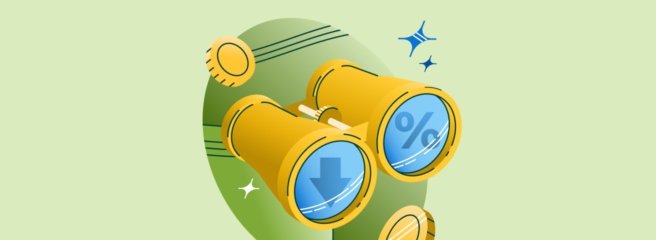
When you hear about the different types of financing available to you for personal purchases, you’re likely most familiar with credit cards or personal loans—both of which may be great options for you, depending on your needs. But did you know there’s another choice, one that offers a lot of flexibility?
We’re talking, of course, about personal lines of credit. In this quick guide, we’ll get into what they are, how they work, the pros and cons of opening one, and how they compare to personal loans and credit cards.
What is a personal line of credit?
To dive into the specifics of a personal line of credit, we should first answer these questions: what is a line of credit and how does a line of credit work?
There are several different types of lines of credit, but overall, a line of credit is simply an arrangement between you and a financial lender (usually a bank) that establishes a predetermined borrowing limit you can tap into at any time. You can take money out as you need it until you reach your limit.
How does it work?
With a personal line of credit (PLOC), the loans are open-ended with funds that can be accessed through bank transfers or line-of-credit checks. These lines of credit can be issued for limits that range from $1,000 to more than $100,000.
Interest begins accruing immediately once you withdraw the money. Like a credit card, borrowers make minimum monthly payments. The minimum repayment amount fluctuates, but can be charged as a fixed fee or percentage of the balance owed.
With a personal line of credit, you’re generally able to use the money however you’d like, as long as the amount you’ve spent falls under your credit limit.
When taking out a personal line of credit, pay close attention to the loan’s terms, particularly when it comes to the terms of repayment. While most personal lines of credit function like credit cards, others may have repayment terms that could be inconvenient.
Here are a few less common forms of repayment you should know about:
- Balloon payment. A personal line of credit may require payment of the entire balance at the end of the term (known as a balloon payment). If you’re not able to repay the full amount, you’ll have to refinance.
- Draw and repayment periods. Some personal lines of credit may feature separate draw and repayment periods. This lets you withdraw funds only during the draw period while requiring you to make monthly payments during the repayment period.
- Demand line of credit. In rare cases of a demand line of credit, the lender can call the loan for repayment at any time. This could lead to added stress and anxiety if you’re not financially prepared.
You should consider several factors when exploring your options. A personal line of credit can be a great option for some borrowers, while others may do better with a different financing option.
Let’s get into some of the pros and cons of personal lines of credit you should weigh in your decision-making process.
Drawbacks of a personal line of credit:
- Interest rates are variable. Line of credit interest rates are subject to change at any time, which can make it tough to predict your monthly payment and total costs. This change won’t come out of the blue, however. The bank or issuer has to give you notice in advance that your line of credit rates are changing.
- Low credit score? You may not qualify. Banks and lenders rely on your credit score and your payment history when they grant personal lines of credit. If you have poor credit—or even no credit—this may not be an option for you. Most lenders require a credit score of 700 or above to qualify.
- Surcharges and maintenance fees. It’s common for lenders to charge annual or monthly maintenance fees on a personal line of credit, so you may want to look for a bank or lender that waives these fees for the life of the loan.
- Higher rates. Personal lines of credit are usually unsecured loans, which means they don’t require any collateral from the borrower. While this may be a pro for some, that also means that the line of credit may come with higher interest rates than loans that do require collateral.
- Temptation to overspend. It’s easy to access funds once a line of credit is established, which makes it easy to take out more money than you can comfortably pay back.
Benefits of a personal line of credit:
- Pay interest only on the funds you use. If you take out a personal line of credit, you owe interest only on the money you withdraw from the loan, as opposed to paying interest on the overall loan amount available to you.
- Flexible access and consistent cash flow. With a PLOC, you have access to the overall limit of your loan throughout your predetermined time period, which typically lasts years. And once you’ve paid back the amount you’ve borrowed from your line of credit, the full amount becomes available to borrow again.
- Potential to pay off high-interest debt. A personal line of credit can be used for a variety of needs, so it can be a great way to pay off higher-interest debts like student loans.
What’s the difference?
How should you decide which financing option is right for you? Let’s take a closer look at some of the key differences between a personal line of credit and two other popular financing options—personal loans and credit cards.
Personal line of credit vs. personal loan
Whether you choose a personal line of credit or a personal loan comes down to a matter of preference and the situation you’re in.
With a personal loan:
- You may find it easier to budget because the repayment terms are laid out for you from the start.
- You don’t have to put up any assets or collateral when it comes to unsecured personal loans.
- You need to know how much money you need to borrow, as you’re only approved for a fixed amount of money and you must repay it at a fixed payment over a fixed period of time. Common reasons people take out personal loans include debt consolidation and covering major medical expenses. In both cases, you already know the dollar amount you’ll need.
With a personal line of credit:
- You have flexibility when borrowing. You can borrow up to your maximum limit, repay those funds, and then borrow again as you need to.
- You can borrow, pay down your balance, and access your available credit line again and again.
- You don’t have to know in advance how much money you’ll need. This is best-suited for ongoing projects with unknown costs, like home remodeling projects.
The application process for applying for a personal loan and a personal line of credit is similar. A bank or lender will take a hard look at your credit history, income, and assets to decide whether you’re a safe risk. Your odds of getting approved for either type of financing are best when you have solid credit, though lenders may want your credit to be in better shape for a line of credit.
Personal line of credit vs. credit card
While both personal lines of credit and credit cards let you borrow up to your credit limit as often as you’d like, there are some key differences between the two:
- Interest rates. Interest rates on personal lines of credit are typically lower than they are for credit cards.
- Different limits. With PLOCs, borrowing limits are often higher, making them a better fit for expensive, ongoing projects like home renovations.
- Grace periods. When you open a new credit card, there’s usually a grace period in the beginning where you don’t have to pay interest. There’s no such grace period with a PLOC.
- Length of account. PLOCs have a predetermined length of time you can access them, whereas credit cards can be open indefinitely.
The bottom line: Should you consider a personal line of credit?
Deciding whether a personal line of credit is the right choice for you is a decision to consider carefully. Take into account several factors, including your financial situation, credit history, and ability to cope with fluctuating interest rates.







 Won't affect your credit score¹
Won't affect your credit score¹